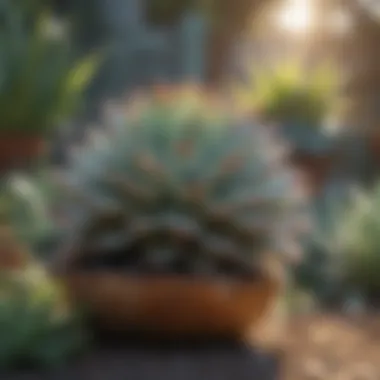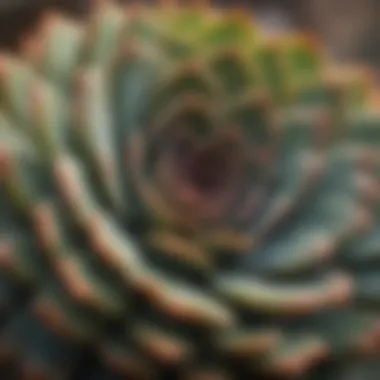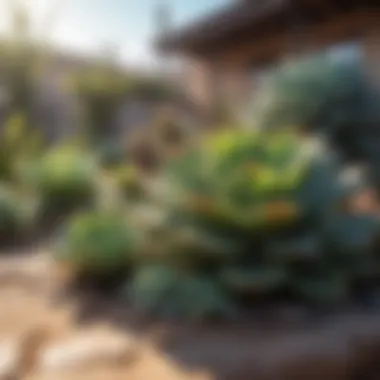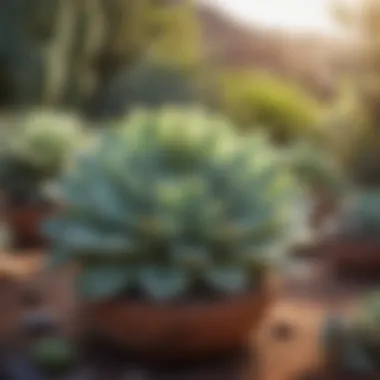Discover Large Succulent Plants Perfect for Outdoors


Intro
Large succulent plants offer a distinct aesthetic and practical advantage for outdoor environments. With their unique ability to thrive in arid conditions, these plants serve as not just eye-catching decorations but also play a critical role in sustainable gardening. In this discussion, we explore a variety of species, their specific needs for optimal growth, and how cultivating these resilient plants can enhance the beauty and functionality of outdoor spaces.
Fascinating Facts About Large Succulents
Unique Characteristics
Large succulent plants come in various forms and colors. Some species, such as the Agave americana, can reach impressive heights while maintaining a striking appearance. These plants store water in their leaves, allowing them to survive in dry climates. Their thick, fleshy foliage serves as an adaptation to their environments, ensuring they remain lush and healthy even when rainfall is scarce.
Extraordinary Adaptations
Besides water storage, many succulents feature unique adaptations for survival. Some develop waxy coatings that minimize water loss, while others possess specialized root systems that gather moisture effectively from the surrounding soil. This resilience makes them ideal for regions with limited water resources.
Succulents exhibit a range of adaptations, making them some of the most resilient plants suitable for outdoor cultivation in challenging environments.
Ideal Growing Conditions
Large succulents thrive in environments with plenty of sunlight. Generally, they prefer a minimum of six hours of direct sunlight daily. However, some species may tolerate partial shade if necessary. Adequate drainage is essential, as succulents are prone to rot if left in overly moist conditions. Well-draining soil or containers is recommended to prevent this issue.
Maintenance Requirements
Maintaining large succulent plants is relatively straightforward. Water them sparingly, allowing soil to dry out completely between sessions. During the growing season, typically spring and summer, they may benefit from diluted fertilizer every month. Regularly removing dead leaves and debris helps prevent pests, ensuring the health of your plants.
Aesthetic Value
Integrating large succulents into outdoor spaces adds depth and texture to any garden. Their diverse shapes and sizes provide visual intrigue, complementing a range of design styles. Whether placed in focal points or as part of larger arrangements, large succulents can transform ordinary landscapes into extraordinary settings.
Environmental Benefits
Utilizing large succulent plants can also contribute to environmental sustainability. Their ability to withstand prolonged drought periods reduces the need for excessive watering. Additionally, they provide habitat for various organisms, supporting local ecosystems.
The End
In summary, large succulent plants represent a beautiful and pragmatic choice for outdoor gardening. With their unique characteristics, minimal maintenance requirements, and remarkable adaptability, they can truly enhance any garden. Understanding the needs and benefits of these plants allows gardeners to maximize their outdoor spaces effectively.
Prologue to Succulent Plants
Succulent plants have captured the interest of both novice and experienced gardeners. Their unique adaptations enable them to thrive in a range of environments, particularly outdoors. In this section, we will explore some critical aspects of succulents. This understanding sets the stage for why large succulent plants deserve a place in outdoor landscaping.
Definition and Features of Succulents
Succulents are defined by their ability to store water in their leaves, stems, and roots. This adaptation allows them to survive in arid conditions. They come in various shapes, sizes, and colors, displaying a striking visual appeal. Common features of succulents include thick, fleshy leaves and a waxy coating which reduces water loss. Some of the well-known species like Aloe Vera or Agave are exemplars of this unique morphology.
Visually, succulents range from the rosette shapes of Echeveria to the towering spikes of certain Agave. This diversity contributes to their aesthetic value in outdoor settings. Their resilience is another feature that showcases their suitability for various climates. With minimal care, they can flourish in gardens, patios, or as focal points in outdoor designs.
Why Opt for Large Succulents Outdoors
Large succulent plants bring several benefits to outdoor spaces. First, their striking architectural forms create dynamic visual interest. They serve as excellent focal points due to their size and unique characteristics. Additionally, large succulents require less maintenance compared to traditional garden plants. Once established, they often thrive with minimal watering and care.


Moreover, incorporating large succulents in landscaping contributes to water conservation. Their drought-resistant nature makes them ideal for eco-friendly gardening. By reducing the need for frequent watering, they promote sustainable landscaping practices.
Finally, large succulents provide shelter and food for local wildlife, including pollinators. This establishes a beneficial relationship between the plants and surrounding ecosystems.
“Succulents not only enhance the aesthetic appeal of a garden but also contribute to sustainable practices and local biodiversity.”
Understanding these foundational principles about large succulent plants prepares gardeners to deploy them effectively in outdoor settings, maximizing both their beauty and environmental benefits.
Choosing the Right Large Succulent Plants
Choosing the right large succulent plants is crucial for creating a beautiful and sustainable outdoor environment. The selection process involves evaluating several factors, including climate, soil conditions, and aesthetic preferences. Large succulents can add unique textures and forms to a garden, making it visually compelling while also being resilient and low-maintenance. Making informed decisions helps maximize their benefits in terms of both appearance and environmental contributions.
Popular Species for Outdoor Settings
Aloe Vera
Aloe Vera is a standout among large succulents due to its numerous health benefits. This plant is known for its fleshy, serrated leaves that store moisture, allowing it to survive in dry conditions. Its ability to thrive in various outdoor environments makes Aloe Vera a popular choice. A unique feature of Aloe Vera is its gel, which is often used in skincare products for its soothing properties. Growing Aloe Vera can be advantageous as it not only beautifies a space but also provides easy access to natural skin remedies. However, it is important to note that while Aloe Vera is hardy, excessive moisture can lead to root rot.
Agave
Agave is another excellent selection for outdoor settings. This succulent is known for its architectural shapes and striking rosettes. It can tolerate drought and extreme heat, making it suitable for many climates. The unique feature of Agave is its sharp, pointed leaves, which can serve as natural deterrents against browsing animals. Its size can reach impressive heights, creating focal points in a garden. However, gardeners should be cautious of its spines, as they may present a risk when planting or maintaining the area around them.
Sedum
Sedum offers versatility in outdoor gardens, thanks to its wide variety of species and growth habits. This succulent can form dense mats or tower upward, providing a distinctive aesthetic. Notable for its drought resistance, Sedum can thrive in poor soil conditions. One of its key characteristics is its ability to produce vibrant flowers, attracting pollinators such as bees and butterflies. Moreover, Sedum requires very little maintenance, making it an ideal choice for busy families. However, it can spread aggressively, so monitoring its growth is essential to prevent unwanted overreach.
Echeveria
Echeveria is cherished for its vibrant colors and rosette shape, providing a decorative touch to any outdoor space. This succulent comes in various varieties, each presenting different leaf textures and colors. One notable aspect of Echeveria is its tolerance to partial shade, allowing it to fit into various garden locations. This makes it a popular choice for layering within garden beds. Although Echeveria is relatively low-maintenance, it prefers well-draining soil to avoid root issues.
Size and Growth Potential
The size and growth potential of large succulents can vary widely based on species and environmental conditions. Selecting plants with the appropriate growth expectations is essential to ensure compatibility with garden space. Furthermore, understanding the growth rate of these succulents allows for informed planning regarding garden design and overall maintenance. Incorporating large succulent plants effectively can create a balanced, sustainable landscape that requires minimal resources, offering beauty through simplicity.
Ideal Growing Conditions
Understanding the ideal growing conditions for large succulent plants is essential to promote their health and longevity. Correct conditions not only enhance growth but also ensure that these plants thrive in outdoor settings. This section explores critical aspects like climate, soil types, and sunlight requirements for large succulents.
Climate Considerations
The climate plays a pivotal role in the successful cultivation of large succulent plants. Succulents are primarily found in arid regions where conditions are warm and dry. This natural habitat influences their requirements. Temperature variations can affect how succulents adapt. For example, many species can tolerate temperatures ranging from as low as 20°F to as high as 100°F. However, extreme fluctuations in temperature can cause stress. Therefore, consider local climate data when selecting plants.
- Hardiness Zones: Familiarize yourself with your garden's hardiness zone. Large succulents like the Agave americana generally fare well in USDA Zones 8 to 10, while others, like the Aeonium arboreum, thrive in slightly milder climates.
- Humidity Levels: Succulents prefer low humidity. They can suffer from rot if exposed to excessive moisture. When planting, aim for areas that have good air circulation to prevent damp conditions.
Soil Types and Composition
Soil is another key factor in curating appropriate conditions for large succulents. Unlike many other plants, succulents require well-draining soil to avoid root rot. Several soil types suit these plants best:
- Cactus Mix: A commercial cactus mix is ideal, usually comprising sand, perlite, and organic matter.
- DIY Mix: For a more tailored approach, consider creating your own mix. Combine regular potting soil with sand and perlite in a 1:1:1 ratio. This blend ensures drainage while retaining essential nutrients.
- pH Levels: The ideal pH level for most succulents is around 6.0 to 7.0. You can test your soil's pH with kits available at garden stores.
Sunlight Requirements


Sunlight is fundamental for large succulents' growth and health. These plants require ample sunlight to photosynthesize effectively. Generally, most large succulents thrive in full sun, which is about 6 hours of direct sunlight daily. However, consider the following:
- Location: When selecting a site, look for a spot that receives morning light and some afternoon shade. This arrangement protects the plants from the harsh afternoon sun, especially in extremely hot climates.
- Signs of Stress: Pay attention to the plants. If they exhibit signs of etiolation, such as becoming leggy or stretching towards the light, it may indicate insufficient sunlight.
- Varietal Differences: Some species, like Echeveria, can tolerate partial shade. Conversely, many Agave species thrive under full sunlight. Hence, researching specific varieties is crucial.
Careful consideration of climate, soil, and sunlight for large succulents ensures that they flourish in outdoor settings. Proper conditions lead to healthier plants and a more vibrant garden.
Cultivation Techniques for Large Succulents
Cultivating large succulents successfully requires understanding and implementing specific techniques tailored to their needs. Proper cultivation enhances growth, yields healthier plants, and ensures their longevity in outdoor settings. For anyone interested, knowing how to care for these unique plants integrates specific methods, from planting to watering and fertilization.
Planting Methods
Planting large succulents involves a careful approach. First, selecting the right location is crucial. They thrive in well-draining soil, so choose an area that does not retain water. Planting in containers is also an option, as this allows for flexibility in placement and easier management.
When planting, dig a hole that is twice as wide and just as deep as the root ball. This allows roots to spread easily. Position the plant so the crown sits slightly above soil level. Cover the roots gently but avoid compacting the soil too tightly. Water lightly after planting to settle the soil without waterlogging.
Watering Practices
Watering is essential for the health of large succulents. They require a different approach than most plants due to their water retention capabilities.
Frequency
Frequency in watering largely hinges on environmental conditions such as climate and soil type. Generally, it is better to underwater than overwater. A common practice is to water once every two weeks during the growing season and reduce to once a month in winter. This method prevents root rot while allowing the plant to access necessary moisture when it truly needs it.
A key characteristic of this frequency is its adaptability. Users can adjust based on rainfall or extreme heat. This flexibility makes it a beneficial choice for regions with varying climates.
Water Quality
Water quality is another key factor in succulent health. Using rainwater or distilled water is recommended, as tap water often contains minerals that can affect plant health. The unique feature of using high-quality water is that it ensures that concentrations of salts and chemicals, which might harm the plant, are minimized.
Incorporating high-quality water can result in stronger and more resilient plants. However, it may require more effort to secure appropriate water sources, especially in regions reliant solely on tap water.
Fertilization Strategies
When it comes to fertilization, large succulents do not require as much nourishment as other plants. However, using the right fertilizer can significantly enhance growth and appearance. A balanced, diluted liquid fertilizer formulated for cacti or succulents can be applied during the growing season. This strategy allows the succulent to absorb nutrients without overwhelming its system. Fertilizing sparingly encourages plants to develop their water-storing capabilities, leading to better drought resistance.
With these cultivation techniques, anyone can ensure the successful growth and longevity of large outdoor succulents, providing beauty and resilience to their outdoor spaces.
asdfsadfsdf
Aesthetic Enhancements in Outdoor Design
Aesthetic enhancements play a vital role in the design of outdoor spaces, particularly when large succulent plants are involved. Succulents are not just resilient; they possess unique shapes, colors and textures that add depth to any garden. When arranged thoughtfully, they can create a harmonious landscape that serves both beauty and function.
Pairing Succulents with Other Plants
Integrating large succulents with other plants can significantly improve the overall appeal of an outdoor area. Combining succulents with drought-resistant flowers such as Lavender or Salvia can create a visually striking contrast. The color of the blooms often complements the rich greens and subtle hues of succulent leaves. Additionally, incorporating various heights by mixing succulents with taller plants, like Yucca or Cortaderia selloana, can provide dimension to your garden.
Key Considerations:
- Color Schemes: Aim for a balance between vibrant blooms and the softer shades of succulents.
- Growth Habits: Ensure the plants chosen have compatible growth rates and space requirements to prevent overcrowding.
- Texture and Form: Varying leaf shapes enhances visual interest. For instance, spiky agaves alongside rounded sedums create a compelling textural contrast.


Creating a Succulent Garden
Establishing a dedicated succulent garden creates a focal point that can draw people’s attention. When planning, consider the garden's layout carefully. Grouping plants by their size and care requirements facilitates maintenance and growth. A well-planned arrangement can offer an oasis of tranquility.
Steps to Consider:
- Location: Select an area with ample sunlight. Succulents thrive in bright light but also need some protection from harsh afternoon sun.
- Design Styles: Consider themes such as minimalist, Mediterranean, or desert-inspired to guide your selection.
- Layering: Position tall plants in the back and shorter ones in front, allowing each plant's characteristics to shine.
Using Planters and Arrangements
The container choice greatly influences the aesthetic of succulent arrangements. Planters come in various materials and styles, from terracotta pots to modern fiberglass containers. The choice of planter can either enhance or detract from the succulents' natural beauty.
Practical Tips:
- Size Matters: Ensure that containers are large enough to support the growth of larger succulents, avoiding stunted development.
- Drainage: Proper drainage is crucial. Consider pots with drainage holes or use potting mixes designed for succulent care.
- Decorative Elements: Use pebbles or decorative rocks on top of the soil to elevate the presentation.
Key Takeaway: Thoughtful arrangement and pairing of succulents with other plants can transform an ordinary outdoor space into a vibrant, engaging environment.
Environmental Benefits of Large Succulents
Large succulent plants are not only visually appealing but also contribute significantly to environmental health. Their role in outdoor spaces extends beyond ornamental value. Understanding the environmental benefits of these plants is essential for gardeners and enthusiasts alike. This section explores how large succulents can conserve water, attract pollinators, and contribute to a healthier ecosystem.
Water Conservation
One of the primary advantages of large succulents is their ability to conserve water. These plants have evolved to store water in their leaves, stems, and roots. This characteristic makes them incredibly drought-resistant. In regions where water scarcity is an issue, incorporating succulents can lead to significant reductions in water usage for landscaping.
- Drought Tolerance: Large succulents, like Agave and Aloe Vera, require less frequent watering compared to traditional plants. Their thick leaves help them retain moisture, allowing them to thrive in arid conditions.
- Soil Moisture Retention: The deep root systems of large succulents enable them to access underground moisture. This not only sustains the plants but can also improve soil moisture levels for surrounding flora.
- Sustainability in Landscaping: Using large succulents contributes to sustainable gardening practices. They require minimal irrigation, thus reducing the demand on local water supplies.
“Large succulents are a vital tool in the fight against drought and water wastage in gardening.”
Attracting Pollinators
Pollinators play a crucial role in maintaining biological diversity and food production. Large succulents, despite their appearance, can attract a variety of pollinators, including bees, butterflies, and hummingbirds. Their unique flowers and prolonged blooming seasons provide essential resources for these species.
- Flowering Species: Some succulents, such as Sedum and Echeveria, produce vibrant flowers that are rich in nectar. These blooms are not only beautiful but also serve as a food source for pollinators.
- Supporting Biodiversity: By planting large succulents, gardeners can create habitats that support pollinator populations. This is especially important in urban areas where natural habitats are diminished.
- Evolving Flora: The presence of pollinators encourages cross-pollination, enhancing the genetic diversity of various plants in the surrounding ecosystem.
Ecosystem Contributions
Large succulents are integral components of healthy ecosystems. Their presence contributes to various ecological functions that benefit both the environment and human enjoyment.
- Soil Erosion Prevention: The robust root systems of large succulents help stabilize soil, reducing erosion, especially in sloped areas. This stability is crucial in maintaining soil quality and reducing runoff.
- Microclimate Regulation: Large succulents can influence local microclimates. They provide shade and help regulate temperatures, which benefits nearby plants and animals.
- Support for Wildlife: In addition to attracting pollinators, large succulents can provide shelter and food for various wildlife species. This interaction fosters a dynamic ecosystem that enhances resilience and stability.
Incorporating large succulents into outdoor spaces offers numerous environmental benefits. From conserving water to supporting pollinators and contributing to ecosystem health, these plants serve as a valuable asset for sustainable gardening practices.
Finale and Final Thoughts
Summarizing the Importance of Large Succulents
Large succulents hold a significant place in modern gardening practices. They offer a variety of benefits that extend beyond mere aesthetics. First, their ability to store water allows them to thrive in conditions where other plants may struggle. This characteristic makes them ideal for regions that experience droughts or have limited water supply. Additionally, large succulents can create a focal point in outdoor spaces. Their unique shapes and sizes draw attention, making them valuable in landscape design.
Moreover, the presence of large succulent plants can positively influence local eco-systems. They often attract a variety of pollinators, such as bees, which are critical for the health of other plants. Their resilience allows them to survive in diverse conditions, contributing to a more robust ecological framework.
Incorporating large succulents into outdoor gardens can not only enhance the beauty of the space, but also sustainable practices and biodiversity.
Encouraging Sustainable Gardening Practices
Families and individuals can take this approach to gardening, thus fostering a sense of responsibility towards nature. This not only enhances the garden’s beauty, but also serves as an educational opportunity for all ages about ecological balance and responsibility. Emphasizing sustainability is vital in today’s rapidly changing world. Choosing large succulents fosters a practice that is beneficial to both the environment and the local community.







